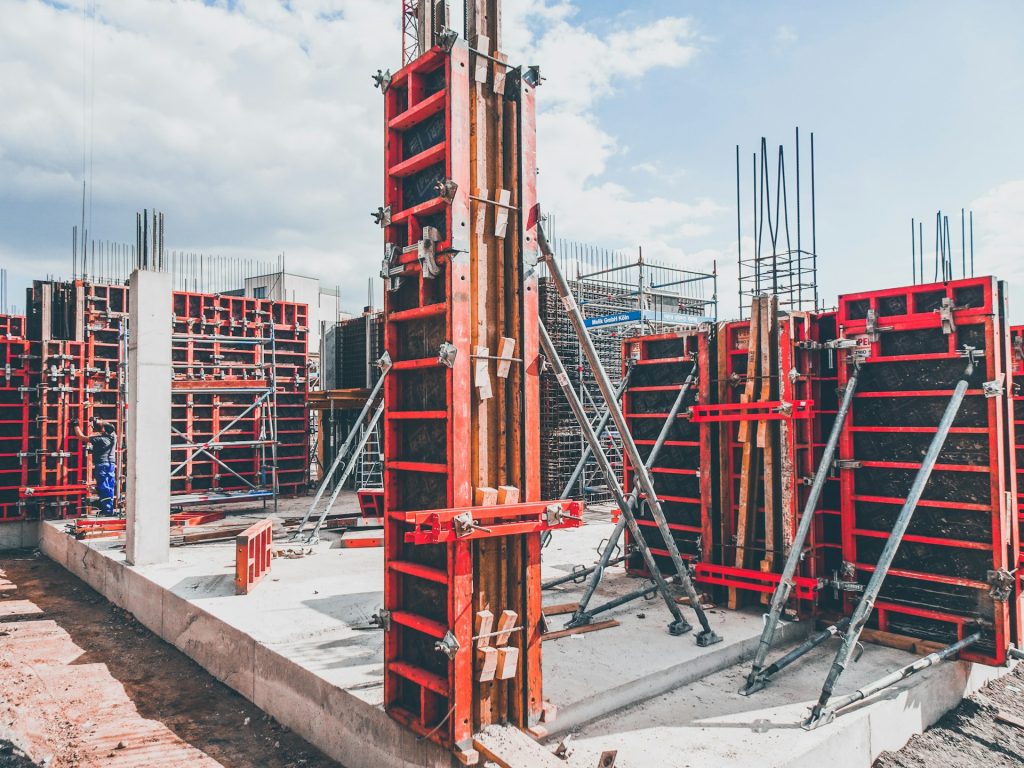In the construction industry, a variety of building materials are employed to create structures that are not only durable but also aesthetically pleasing. Here are five types of building materials commonly used in construction:
1. Concrete:
Composition: A mixture of cement, aggregates (such as sand and gravel), and water.
Use: Concrete is a versatile material used for foundations, slabs, columns, and beams. It provides strength and durability to structures.
2. Bricks:
Composition: Traditionally made from clay or concrete materials.
Use: Bricks are a classic choice for construction, utilized by bricklaying firms in walls, facades, and partitions. They offer both structural support and visual appeal.
3. Wood:
Composition: Timber sourced from various types of trees.
Use: Wood is commonly used for framing, flooring, and finishing work. It provides a natural and warm aesthetic and is often used in residential construction.
4. Steel:
Composition: An alloy of iron and carbon, often with other elements.
Use: Steel is used for structural framing, reinforcing concrete, and creating components like beams and columns. It adds strength and stability to buildings.
5. Glass:
Composition: Silica, soda ash, and limestone.
Use: Glass is utilised for windows, doors, and facades. It allows natural light into the building, contributes to energy efficiency, and provides a modern aesthetic.
These building materials, in various combinations, contribute to the strength, stability, and visual appeal of structures in the construction industry. Each material has its unique properties, making it suitable for specific applications in building projects.
6. Plaster:
Composition: A mixture of gypsum, lime, or cement, combined with sand and water.
Use: Plaster is applied to walls and ceilings to create a smooth and finished surface. It enhances the aesthetic appeal of interiors and provides a protective layer.
7. Asphalt:
Composition: A sticky, black, and highly viscous liquid or semi-solid form of petroleum.
Use: Asphalt is widely used for road construction and roofing. Its waterproof and durable nature makes it suitable for surfaces that endure heavy traffic or exposure to the elements.
8. Aluminium:
Composition: A lightweight metal with excellent corrosion resistance.
Use: Aluminium is employed for windows, doors, roofing, and cladding. Its versatility, strength, and resistance to corrosion make it a popular choice in construction.
9. Fiberglass:
Composition: Thin strands of glass woven into a flexible fabric.
Use: Fiberglass is used for insulation, reinforcing materials, and in the production of lightweight panels. Its insulation properties contribute to energy efficiency in buildings.
10. Ceramic Tiles:
Composition: Fired clay, often with a glaze coating.
Use: Ceramic tiles are commonly used for flooring, walls, and decorative purposes. They are durable, easy to clean, and come in a variety of designs, adding a decorative element to construction projects.
Incorporating a combination of these building materials allows construction professionals to meet structural requirements, aesthetic preferences, and environmental considerations. The diverse range of materials ensures that buildings are not only functional and resilient but also visually appealing and tailored to specific needs.
11. Insulating Materials:
Composition: Various materials such as fibreglass, foam, and mineral wool.
Use: Insulating materials are crucial for maintaining energy efficiency. They are used in walls, roofs, and floors to regulate temperature and reduce energy consumption.
12. Adhesives and Sealants:
Composition: Synthetic polymers or rubber-based compounds.
Use: Adhesives and sealants are vital for bonding materials and creating airtight seals. They are used in construction for tasks such as installing flooring, attaching panels, and sealing joints.
13. Plastic/PVC:
Composition: Synthetic polymers, including polyvinyl chloride (PVC).
Use: Plastic is employed in various construction applications, from plumbing pipes to window frames. PVC, in particular, is durable, low-maintenance, and resistant to moisture.
14. Stone:
Composition: Natural stones like granite, marble, and limestone.
Use: Stone is utilised for both structural and decorative purposes. It adds a timeless and elegant aesthetic to buildings, often seen in cladding, flooring, and architectural details.
15. Gypsum:
Composition: Calcium sulfate dihydrate.
Use: Gypsum is used in construction for creating drywall, plaster, and other building components. It is valued for its fire-resistant properties and versatility in interior finishes.
Conclusion:
The selection and combination of these diverse building materials allow construction professionals to tailor projects to specific needs, taking into account factors such as durability, aesthetics, energy efficiency, and functionality. As the construction industry continues to evolve, the use of innovative materials and sustainable practices is becoming increasingly prevalent, shaping the buildings of the future. This dynamic interplay of materials ensures that structures not only stand the test of time but also contribute positively to the environment and the well-being of their occupants.
Whether it’s the timeless elegance of natural stone or the cutting-edge efficiency of insulating materials, the construction industry continually adapts and incorporates a rich palette of materials to construct buildings that are not just structures, but integral parts of our lived environment.



